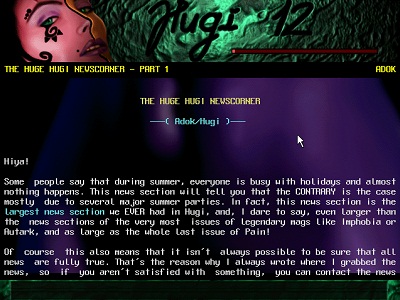
18 Years of Hugi - Looking Back
Introduction
In October 2013 I celebrated my 30th birthday. While I used to be one of the youngest people active in the demoscene for many years, I am certainly still one of the younger ones active today, but there are also people younger than me. Moreover, being 30 years old you cannot attribute immature social behaviour and lack of technical skills simply to your age any more. I am not even a young grown-up any more, I am more or less an average grown-up. At my age, I have already made experiences with the "real world" outside of school and learned many things which I, in the past, was too naive to realize. In fact what I now know of the world outside makes me even more proud of what I have achieved together with all the great people who contributed to Hugi.
When I started making Hugi back in 1996, when I was 12 years old, I had not expected that it would grow so big as it eventually did. It was more of a coincidence that I started making Hugi, since I had originally only planned to contribute to already existing diskmags. But when I was contacted by Kaktus, a German mailswapper, not much older than me, who wanted to make a new diskmag, I agreed that I would code the interface for him. This was how I was made editor of Hugi. For two years the magazine issued in the German language and was mostly composed of articles our penpals gracefully sent us. Then I got Internet access, and the people I met there on IRC stimulated me to trying to make a full-fledged demoscene magazine in the English language, following the model of Imphobia. I invested a large part of my spare time into the project. Fortunately school was no problem for me, which was why I always had a lot of time to use for Hugi.

I was really happy that the eleventh and twelfth issue of Hugi were warmly welcomed in the international demoscene community. From then on, it was easy to receive contributions for the magazine. People such as Antony, Will Be, Hellfire, Scape, Cereal, FloOd, dines, Bridgeclaw and others sent us great graphics, which made reading very enjoyable. Smash, Makke, p-rat, CoaXCable, Steffo, Dawnstar, Laxical, Bacter and others contributed the music, and more than 50 people per issue wrote articles. I am really grateful for all of this. Especially now, having experienced what it is like in the "real world". In the real world, you would have to pay a lot of money to get equally good contributions. Here, in the demoscene, everybody did it for free. Everybody did it as a hobby, because it was fun for them to do what they were especially good at, and they cooperated with each other to create a work that was greater than the sum of its parts.
I think that with Hugi, we have achieved a great thing, which is to be remembered for generations. If you contributed to Hugi and one day decide to have children, you have something to show to them; perhaps also to your grandchildren. We really have something to be proud of.
In the following article I will talk a bit more about what made Hugi so great.
The Switch to the Demoscene
Starting with issue 11, Hugi focused on the demoscene. This was mostly due to the editor of the Cream diskmag, Coctail. His plan was to make Cream a demoscene magazine. This inspired me to deal with the demoscene as well, although we were just beginners at that time. Another person who motivated me to make Hugi a demoscene magazine in the English language was Salami of Ethos9 and Nothing who later also provided a domain and webspace for Hugi. He was a great supporter. Convinced that I would be able to create a good diskmag, he also helped me improve the Hugi engine. Thanks to him I found an elegant way to store all data in the executable file.
The eleventh issue of Hugi (the first one in English) was made in the spirit of earlier demoscene diskmags and contained interviews, party reports, coding tutorials and general demoscene articles which had a rather analytical character. One of the articles published in the Cover section (the predecessor of the Headlines section, which was re-introduced in Hugi only a few issues ago) was inspired by Cream: Coctail had written a long article about the importance of the diskmags for the current scene. I took this theme up again and wrote the article "Demodiskmagscene today". Another of my articles was called "Demos: Art of the 21st Century?", in which I stated that demos must be compatible to the taste of the masses in order to be generally accepted as a form of art. For this reason it would be important to make Windows demos since old platforms such as the C64 are not widespread enough. Today I have a different opinion: An art form need not be compatible to the taste of the masses to be acknowledged; the question is who is to acknowledge the art form. A few German articles were scattered among the English ones. Only those which were not demoscene related were listed at the end of the magazine below the headline "German Section". This German Section led a rather miserable existence in the following issues. Although it did contain scene-related articles starting with Hugi #12, it also continued to have short stories, poems and miscellaneous articles. The old authors mostly went inactive. Later on, with Hugi.GER, they were reactivated for a short time, but Hugi.GER failed to live up to their expectations.
Hugi #12 was mainly shaped by the big success of Hugi in the scene. This was primarily due to my activity in demoscene IRC channels where I told people to take a look at Hugi and then vote at Hornet Charts. Soon Hugi became 2nd in the diskmag charts category after Imphobia. I managed to encourage a lot of people to write articles for Hugi. Some of the subsequent issues had more than 50 authors. I was in contact via IRC or e-mail with all of them. There were also a few who did not submit their contributions via e-mail but contacted me on IRC and sent me their articles via DCC. My IRC activity was partly responsible for people completing and submitting their article drafts.
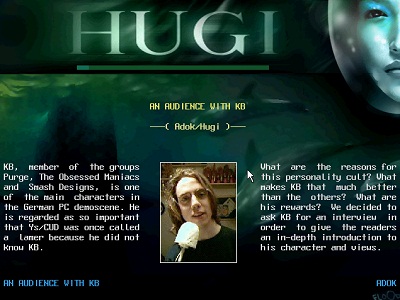
In the summer months of 1998 I collected a lot of news about the demoscene and included it in the news corner of Hugi #12. Thus this corner grew very large. However, it also contained a lot of less interesting news items. Apart from that, the structure of the magazine remained the same for several issues. There were only a few reorderings and three new sections dealing with hardware, music and graphic design. Moreover, we published a lot about other diskmags until the year 1999, such as reviews. But after 1999 hardly any diskmags were released, except Hugi, Pain and Shine. For this reason this section became smaller. But it was my personal favourite since diskmags were my main area of interest. I was also more interested in the scene than the actual demos. Already around issue 13 I told ps in an e-mail that I wanted to publish more articles about topics not related to the scene. Apparently the idea of releasing a scene-only magazine only appealed to me for a very short time.
Real World articles
In fact, there were some non-scene corners in some issues, such as Tomcat's Hungarian army service report in Hugi #23 and the Winamp skinning corner in Hugi #26. This was heavily criticized by some readers at pouet.net, as even mentioned at Wikipedia. Some sceners apparently had no interests but the scene and did not want a scene magazine to deal with other topics. In Hugi #17 I wrote an article about that, in which I expressed my wish to obtain a good general education instead of focusing on one theme. Some sceners, including diskmag editors Ghandy and Dipswitch, argued they were reading magazines such as "Spiegel" in order to learn about topics concerning "real life" and for this reason they were not interested in reading about such topics in a diskmag. My argument against that is that some authors have an urge to write about topics that concern themselves even if they are not related to the scene. Diskmags might give them a platform to express their views. Why should this opportunity not be used? Some authors also have different opinions or perspectives than the mainstream media. In my opinion, it is interesting to read such articles even if one believes to be already well informed about what is happening in the world.
However, due to this attitude I have had an ill success. In 2008 Finnish scener Unseen sent me an article which he claimed to have written himself. I read the article. Its contents were controversial: He argued against immigration from Africa and Islamic countries due to the "intolerant" religion of these immigrants. I was well aware that this article did not match the rules of "political correctness" but I assumed that Unseen wanted to express his opinion. As I appreciate the freedom of speech, I decided not to delete this article but temporarily include it in Hugi #35 and decide later whether I would really publish it.
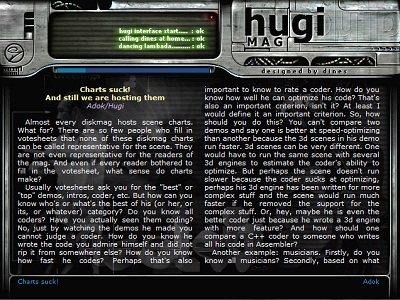
In the end the issue was released including this article, which caused heavy protests at pouet.net. For this reason I replaced this article by another one and re-released Hugi #35 a couple of hours after the first release. Nevertheless the image of Hugi was harmed and we experienced problems in the following months to get articles for the next issue. However, what beat everything was Unseen's statement at pouet.net that he had copied this article from the Internet and it did not really reflect his own opinion, but he sent it to us only to damage Hugi's reputation. This is what made Magic and me decide not to publish any political articles in Hugi any more and dedicate the entire magazine to the demoscene. This has led to positive ratings of the two latest issues.
Technical Aspects and other things
A completely different topic is the technical development of Hugi. The twelfth issue of Hugi saw a change of the engine. The new engine was made by Street Raider for the Russian diskmag Hacker. The version we used in Hugi (with Street Raider's kind permission) was a bit degraded: it did not support the rendered menus which the diskmag Hacker had. However, all other features were used by Hugi, including links to the Internet and the Windows executable. So far, almost all diskmags had been for DOS, so this was a true innovation. This also caused a lot of discussion inside the magazine whether demos should be developed for Windows. In this respect, Street Raider has done pioneering work, and I am grateful for that.
Alas, I am even more grateful to Chris Dragan since his engine Panorama, which he had developed for Hugi and which was first used in Hugi #18, provided a modern layout, making a very professional appearance. The engine introduced support for true type fonts, justified paragraphs, multi-column layout and many more things. It was so good that we even use it today. After Hugi #18 Chris Dragan implemented it again from scratch; after that, it was only updated from time to time. There used to be compatibility issues with new versions of Windows. T$ fixed these bugs. The new engine inspired me again to make Hugi a good diskmag. Nevertheless some readers, such as Tomaes of TAP, have the opinion that Hugi #19 was the best issue. I am not sure if Hugi #19 was really that good; I rather think Hugi was good until issue 23 and only then quality declined due to the lack of time caused by my university studies.
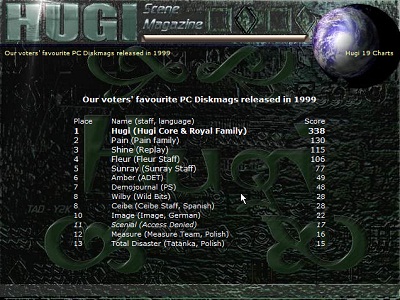
However, nowadays the quality of Hugi is very good again, thanks to Magic, who has been active since issue 32 (released in 2006). He is an old Amiga scener who participated in diskmags already a long time ago. He was a staff member of Chit Chat and Devotion, and even if his style is not as sophisticated as Mop's or RokDaZone's, his articles are usually well researched. Most of all he has a great deal of enthusiasm which makes him contact sceners and get on their nerves until they agree to an interview. Since 2006, Hugi has contained many articles he was involved in, and without him, Hugi probably would not be released any longer. My own tasks mostly concern the proofreading and formatting of text and the inclusion of graphics and music. Occasionally I also write articles, but my personal motivation is not as strong as his.
Several Hugi issues were also translated to Russian. This was initially due to the initiative of a Russian scener, Flux. He translated Hugi #16 almost on his own. Two issues later another Russian scener approached me and expressed his interest in translating work. In this way different teams worked on this project. For a couple of years, no Russian issue has been released any more. Apparently the translators have realized that the effort to translate an issue is higher than the expected outcome. I personally enjoyed it only because some Russian online magazines included quotations of mine, some of which were used as introductions to articles - just like quotations of Lenin used to be in the past.
For some months I also published a weekly demoscene newsletter, HugiNews. Apart from news items it also contained a few articles. But this soon got on my nerves, and after the 38th issue I abandoned this project.
What was less related to the demoscene was the Hugi Coding Compo which happened 29 times. Most participants were no sceners. However, Chris Dragan and TAD became aware of Hugi due to the competitions, as well as Boreal, Bonz, Sniper and a few others. It was also partly my "fault" that Picard was recruited by the demogroup Exceed as high successes at Hugi Compos made them become interested in him. Picard is the programmer of the well-known intro Heaven Seven - so it is partly thanks to Hugi that this intro was made.
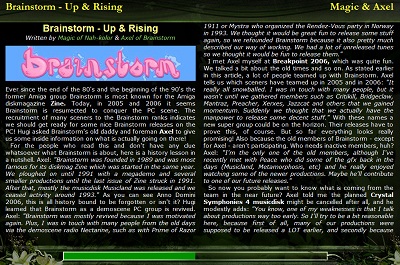
Greetings and Thanks
There are three things I regard as facts:
1. Hugi was very popular among some parts of the demoscene, or rather the community interested in demos, in the years 1998 to 2001.
2. Most of the people who nowadays populate pouet.net and thus represent the demoscene do not belong to the group among which Hugi used to be very popular.
3. Those people who used to like Hugi very much are not interested in the demoscene, and not reading Hugi, any more.
Short said, the times have changed.
On this occasion I would like to thank all those people who have made Hugi the great thing it once was. Please forgive me if I do not recall all important names, but I will try to mention as many as possible.
First of all, thanks to the people I founded Hugi with: Kaktus, TOXO, Activater (aka Scorpe, aka Dreamdancer), LeidPen, SteX Cool Man, Dark Crusher, Cmdr. Data, the contributors to the very first issue of Hugi. Also thanks to the regular contributors to the early German issues who joined a bit later: Karma Sutra, Helmut Schida, Pater Noster, Black Shadow, Muffin, Schnurfel, Onkel Cub, Violencer, Jabberwocky, Mr. M!ke, Peter Dobrovka, Martin Krusche, Chefkoch, Frl. Rührig, XxX (aka HIway, aka DataSUN), ICETEA.
A lot of thanks go to Salami for motivating me to make a demoscene related magazine based on my experiences I had gained by editing the early German issues of Hugi, and also to Coctail who more or less did the same. Moreover, thanks are due to Street Raider for creating the engine that was used in issues 12 to 17, and to Chris Dragan for the engine used ever since. Further thanks go to Makke for his music related articles and compositions, TAD mostly for his coding related articles and for his graphics, Hellfire for providing us with a lot of graphics, also Cereal, Scape, FloOd, dines, Bridgeclaw, CoaXCable, Amoivikos, nldsr, Partikle, Critikill, Fjrb, Dzordan, Fabian, seven11, Zealan, Raven of Defacto2, Raven of Nuance, Tascha, Antony Squizzato, Anthony Gargasz, Fusko, Maali, Charles Pillar, Dendrite, Noogman and all the other great graphics artists for their contributions to Hugi, making it a visually appealing magazine. Thanks also go to the musicians I have not already mentioned, such as Smash, Steffo, Laxical, Dawnstar, Bacter, p-rat, Stanley, Acumen, Andromeda, Nightbeat, Spin, Ciccilleju!, Yero, iliks, Zalza, Gopher, JosSs, Traymuss, Chromag, Romeo Knight, Buzzer, Mice, Siatek, Moby, Avalanche, Slash_AtD and all whose names I have forgot (sorry...). Thanks are also due to more or less regular writers Dario Phong, Paranoid, T$, Zippy, ps, Magellan, Sane, Ghandy, Seven, Tryhuk, Louk, Fable Fox, Optimus, Skal, Marnix Kok, Paradox, tmb, COTDT, Uctumi, Warlock, Masterboy, Sarwaz, Cremax, Dodger, mc-f, N.r.t.h., d-lee, Tomcat, Kombat, EP, mados, DiamonDie, Sol, SacRat, Brioche, Picard, Flux, Nevidimka, Heaven Aeroplane, Sagacity, Skin, Sir Garbagetruck, Whizzter, Quartz, Surfing, Ryg, Phinn, Morph, Otis, Seffren, Deffy, Shadez, Ritz, Entropy, Franky, Sweeper, upi, Bonz, Boreal, Sniper, RaD Man, Bad Sector and all the others who would deserve being mentioned here. Of course, also great thanks to Magic for his strong contributions to Hugi especially since issue 32, although he was already involved as early as in issue 12. Also thanks to the Scene.org staff for hosting the Hugi website for many years, and to Willbe for making the original design, as well as AMcBain for his technical contributions to the online editions.
Greetings to my fellow editors of other diskmags, newsletters, online mags and paper mags with whom I used to be in contact, including Darkness of Imphobia, Fred of Calodox (Pain), Unlock of Vantage (Pain), Baloo of Replay (Shine), Goofy of Replay (Shine), Programmer of UniVerse (Armor of Gods), Civax of Moon Hunters (CFX News), Axel of Brainstorm (ZINE), Killer Taifun (Skyline), Midnight of Knockout (Blackmail), Eric der Schreckliche (MicroCode, Cream), Coplan of Immortal Coil (Static Line), RokDaZone of Endzeit (Generation), Fishwave of Scoopex (Seenpoint), Dj Regal of Tatanka (Amber), Misha of Tatanka (Total Disaster, Amber), Gardner (Measure), Goblin of Xtatic (Restless), Phoenix of Hornet (Restless), closed (Byteshop), Sentinel of Excess (Nitro), Jazzcat of Onslaught (Vandalism News), Nyquist (Digital Talk), Arrakis of K!Prod (Defcon), Terror Kid (Datenpirat), Szum of Cryogen (Dragon), Macno of Abnormalia, Mop of Essence (ROM), Dominei of INF (Daskmig), The Watcher of TUHB (TUHBzine), Spock of Wild Bits (Wilby), Curt Cool of Depth (The Official Eurochart), Boo of Talent (Eurochart PC), Venior of Access Denied (Scenial), CiH (Maggie, Alive), Dazzaboy of Ellesdee (Grapevine Online).
I love you!